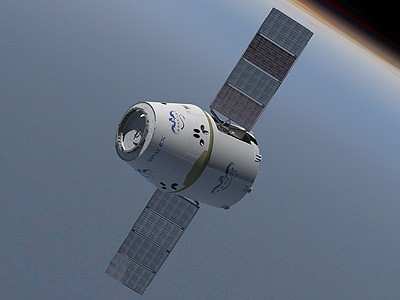Maiden Flight Of The Commercial Rocket Planned For Friday,
Weather Permitting
 SpaceX CEO Elon Musk, and Ken
Bowersox, VP of Astronaut Safety and Mission Assurance, say the
Falcon 9 maiden launch scheduled for Friday has about a 75 percent
chance of success, and regardless of the outcome, the launch is
expected to provide valuable data for continued development of the
commercial space industry.
SpaceX CEO Elon Musk, and Ken
Bowersox, VP of Astronaut Safety and Mission Assurance, say the
Falcon 9 maiden launch scheduled for Friday has about a 75 percent
chance of success, and regardless of the outcome, the launch is
expected to provide valuable data for continued development of the
commercial space industry.
In a conference call with reporters Thursday, about 24 hours
before the scheduled launch, CEO Musk said commercial space
exploration is "the only way forward." Musk said relying on massive
government programs would require massive increases in the space
budget, and "we'll never do anything interesting in space."
 SpaceX and NASA are in discussions
concerning re-supply for the ISS, and Musk said that schedule has
been moved up. The second Falcon 9 flight will be the first under
the NASA COTS program. An empty Dragon capsule will be boosted
to orbit on what is being called the "COTS 1" flight, but the plan
for the "COTS 2" flight is now to carry non-critical cargo to the
ISS. "COTS 3" is now on the schedule as a backup to COTS 2.
SpaceX and NASA are in discussions
concerning re-supply for the ISS, and Musk said that schedule has
been moved up. The second Falcon 9 flight will be the first under
the NASA COTS program. An empty Dragon capsule will be boosted
to orbit on what is being called the "COTS 1" flight, but the plan
for the "COTS 2" flight is now to carry non-critical cargo to the
ISS. "COTS 3" is now on the schedule as a backup to COTS 2.
Musk said that part of his optimism about Friday's test launch
is that Falcon 9 shares many components with the smaller Falcon 1
rocket, but he re-iterated that first flights have about a 50-50
success rate. "The first successful Atlas flight was on flight 13,"
Musk said, "and the Atlas V is arguably now the most reliable
vehicle in the U.S. fleet."
Ken Bowersox, a former NASA astronaut, said the biggest
difference in working in the private sector is the amount of risk
that can be accepted, and the ability to quickly re-group. Bowersox
said a commercial company is likely to reach the end point more
quickly, and at less cost. He used as an example the Falcon 9
second stage. He said that in a NASA program, that engine would
have to be static tested in a complete vacuum, and such a facility
doesn't exist in the private sector. Flying the second stage on a
test flight is far less expensive, he said.
Musk said that hundreds of sensors will cover the Falcon 9 for
its first launch, measuring everything from tank pressure to
dynamic pressure and vibrations. "Just a crazy number of sensors on
the vehicle," he said. Musk expects the critical data to be
analyzed the day after the launch, but that a more detailed
analysis will take about a month. He said the company hopes to
recover the first stage of the rocket, and it has been equipped
with heat shielding and parachutes to make that more likely. But
recovery of the first stage is not one of the criteria
for success. The most critical moment in the flight will likely be
when the first and second stage separate, Musk said. "We've spent a
lot of time testing that, and trying to design something that was
redundant, but generally speaking, when ever you've got a change of
state in flight, that's where things get riskiest."

SpaceX Dragon Artist's Concept
In the end, Musk and Bowersox agreed that companies like SpaceX
are the future of space. Relying on the government would result in
a small number of launches at tremendous expense. And while
Friday's launch may not draw a big crowd, as do shuttle launches,
Musk said that when it becomes a manned system, no matter what
company develops it, people will once again line the beaches and
causeways around the space center. It will, after all, be the first
new manned spacecraft developed in 30 years, he said. But
"eventually, I hope someday it's so routine there's nobody out to
watch, or like a few people at the end of the airport taking
pictures," said Bowersox.
The Falcon 9 launch window opens Friday at 1100 EDT and lasts
for 4 hours. A second window is available Saturday at the same
time. SpaceX will webcast the launch ... but some of us are close
enough that we hope to be able to be there.
 ANN's Daily Aero-Linx (04.16.24)
ANN's Daily Aero-Linx (04.16.24) Aero-News: Quote of the Day (04.16.24)
Aero-News: Quote of the Day (04.16.24) Airborne 04.10.24: SnF24!, A50 Heritage Reveal, HeliCycle!, Montaer MC-01
Airborne 04.10.24: SnF24!, A50 Heritage Reveal, HeliCycle!, Montaer MC-01 Airborne 04.12.24: SnF24!, G100UL Is Here, Holy Micro, Plane Tags
Airborne 04.12.24: SnF24!, G100UL Is Here, Holy Micro, Plane Tags Airborne-Flight Training 04.17.24: Feds Need Controllers, Spirit Delay, Redbird
Airborne-Flight Training 04.17.24: Feds Need Controllers, Spirit Delay, Redbird





